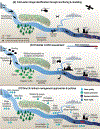Closing the gap between science and management of cold-water refuges in rivers and streams
- PMID: 37466251
- PMCID: PMC10615108
- DOI: 10.1111/gcb.16844
Closing the gap between science and management of cold-water refuges in rivers and streams
Abstract
Human activities and climate change threaten coldwater organisms in freshwater ecosystems by causing rivers and streams to warm, increasing the intensity and frequency of warm temperature events, and reducing thermal heterogeneity. Cold-water refuges are discrete patches of relatively cool water that are used by coldwater organisms for thermal relief and short-term survival. Globally, cohesive management approaches are needed that consider interlinked physical, biological, and social factors of cold-water refuges. We review current understanding of cold-water refuges, identify gaps between science and management, and evaluate policies aimed at protecting thermally sensitive species. Existing policies include designating cold-water habitats, restricting fishing during warm periods, and implementing threshold temperature standards or guidelines. However, these policies are rare and uncoordinated across spatial scales and often do not consider input from Indigenous peoples. We propose that cold-water refuges be managed as distinct operational landscape units, which provide a social and ecological context that is relevant at the watershed scale. These operational landscape units provide the foundation for an integrated framework that links science and management by (1) mapping and characterizing cold-water refuges to prioritize management and conservation actions, (2) leveraging existing and new policies, (3) improving coordination across jurisdictions, and (4) implementing adaptive management practices across scales. Our findings show that while there are many opportunities for scientific advancement, the current state of the sciences is sufficient to inform policy and management. Our proposed framework provides a path forward for managing and protecting cold-water refuges using existing and new policies to protect coldwater organisms in the face of global change.
Keywords: behavioral thermoregulation; climate change adaptation; lotic ecosystem management; refugia; salmonids; temperature; thermal heterogeneity; thermal refuges.
© 2023 The Authors. Global Change Biology published by John Wiley & Sons Ltd. This article has been contributed to by U.S. Government employees and their work is in the public domain in the USA.
Conflict of interest statement
CONFLICT OF INTEREST STATEMENT
The authors have no conflict of interest to declare.
Figures






References
-
- Aboriginal Affaires. (2021). Archeologists explore Mi’kmaq heritage at Mersey River [Press release]. https://novascotia.ca/news/release/?id=20050202003&fbclid=IwAR0KTwg2jhMZ...
-
- Agence française pour la biodiversité/Armines. (2017). Guide technique interactions nappe/rivière—Des outils pour comprendre et mesurer les échanges. https://www.gesteau.fr/document/guide-technique-interactions-napperivier...
-
- Allen P (2005). The Oxbow site 1984; Metepenagiag Mi’kmaq First Nation, Miramichi, New Brunswick. In Stewart FL, Glidden-Hachey S, Gilbert CD, & Suttie BD (Eds.), New Brunswick manuscripts in archaeology (Vol. 39, p. 80). Archaeological Services, Heritage Branch Culture and Sport Secretariat.
Publication types
MeSH terms
Substances
Grants and funding
LinkOut - more resources
Full Text Sources
Miscellaneous

